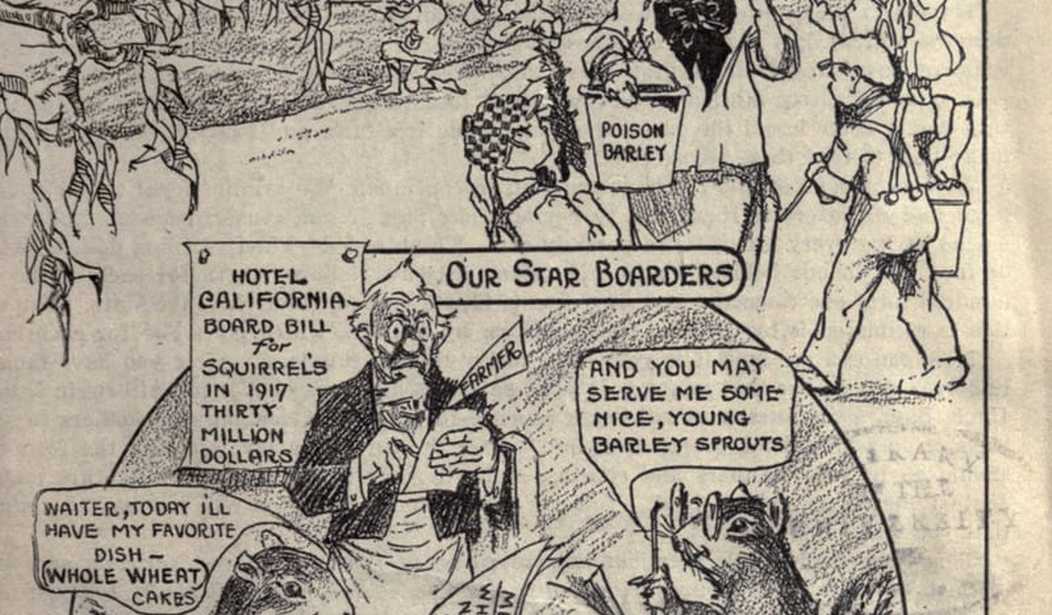Exploiting children took on a whole new meaning in April of 1918. While U.S. infantrymen battled the Germans, “School Soldiers” were sent to the battle lines to help fight a destructive enemy plaguing the homefront: squirrels. George H. Hecke, commissioner of California’s State Horticulture Commission, created what would be known as the “Squirrel Army.” The effort was presented as an extension of the United States’ declaration of war on Germany, which was made the previous year.
“We have enemies here at home more destructive, perhaps, than some of the enemies our boys are fighting in the trenches,” said Hecke. By organizing “a company of soldiers” in their classes or in schools, children were encouraged to help annihilate their ultimate foe—the ground squirrel. The rodents were a source of bubonic plague back then, and the cause of an estimated $30 million in crop devastation. That’s equivalent to $480 million today. Hecke called for “Squirrel Week,” which ended up being seven days of murder and mayhem.
Forty-thousand dollars was used from California’s wartime emergency fund to kick off the anti-squirrel campaign. Thirty-four thousand posters and 500,000 leaflets were put together and distributed to citizens.
Kids were enticed to join Hecke’s call to arms with pamphlets and posters that were titled “Kill the Squirrels.” The posters declared that the state was looking for patriotic children to do their bidding by sprinkling poison outside of the rodents’ underground homes.
The artwork was especially intriguing, as it depicted a woman holding a pail filled with poison barley, smiling and saying, “Children, we must kill the squirrels to save food. But use poisons carefully.”
The light reading also included recipes for poison and other methods of murder, including drowning, shooting, and poison gas.

A bit of healthy competition was encouraged when a cash reward was offered to the child who could kill the most squirrels. Fifty dollars was the top prize for elementary and high school students, and prizes of $30 and $20 were offered to the runners-up. The children were asked to bring in the tails of their victims as a way to verify their kill. The concept was seen as practical when president Herbert Hoover, who was then the United States Food Administrator, offered his “hearty approval” of the program that would save “vast quantities of food which might otherwise be used for support of our armies abroad.”
“Kill the Squirrel” cartoons, essentially propaganda, were also created depicting squirrels as German soldiers wearing spiked helmets and iron crosses. The father squirrel wore a upturned mustache, much like Kaiser Wilhelm’s. The Four-Minute-Men, volunteers who delivered four-minute speeches to garner support for the war efforts, had talking points designed to convince ranchers and farmers to kill the “little ally of Kaiser.” They included:
- The BEST squirrel is the dead squirrel.
- The Hotel California board bill for ground squirrels in 1917 […] was $30,000,000—yet unpaid.
- The squirrel does not recognize daylight saving. He uses it all.
- He preys on our crops in countless hordes. He fills the ranks of the killed in true military fashion.
- Why hesitate? We can get ‘em. How? Poison ‘em, gas ‘em, drown em’, shoot ‘em, trap ‘em, submarine ‘em.
- Are you not willing then to give your whole-hearted support to this state-wide movement to KILL THE SQUIRREL?
By the end of Squirrel Week, children had handed in over 104,509 tails, marking the effort as a huge success. Crops bounced back and the children enjoyed killing the vermin so much that it continued for an “indefinite period.” How’s that for an extra-curricular activity?










Join the conversation as a VIP Member